

Beyond their specifications, the proper use of drywall screws is essential for achieving the desired outcome in any project. It is vital to choose the correct length based on the drywall thickness—typically, screws should penetrate at least 5/8 inch into wood or metal stud for maximum stability. This ensures the drywall is securely attached, preventing sagging or bubbling over time. In addition to choosing the appropriate screw type and length, the installation process demands precision. The screw should sit just below the drywall surface, but not too deep as to break the paper surface, compromising the integrity of the drywall. Utilizing a drywall screw setter can help achieve this delicate balance, ensuring the head is perfectly placed every time. Different coatings on drywall screws, such as phosphate or zinc, offer additional protection. Phosphate-coated screws resist corrosion and are ideal for indoor use, while zinc-coated screws provide added rust resistance, making them suitable for outdoor or moisture-prone environments. To further ensure the success of drywall projects, investing in quality products cannot be overstated. Reputable brands adhere to stringent manufacturing standards, offering reliability that often translates into time and cost savings. In summary, understanding the distinct types of drywall screws and their specific applications is critical for anyone engaged in construction or DIY drywall installation. Coarse-thread screws work best for wood, fine-thread screws for metal, self-drilling for efficiency, and self-tapping for sturdiness. By selecting the right type, length, and coating, and committing to precise installation techniques, one guarantees a project that stands the test of time, embodying professionalism and durability in every facet.

















